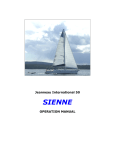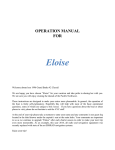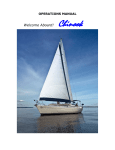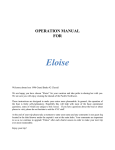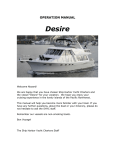Download OPERATIONS MANUAL - Anacortes Yacht Charters
Transcript
1 OPERATION MANUAL VELOCITY 1995 Hunter 430 OWNER/HOSTS Kirk and Lisa Knudsen Mount Vernon. WA 2 Welcome aboard! We are happy you have chosen Velocity for your vacation. Velocity is a Hunter 430. She was commissioned in Seattle in 1995 and has spent much of her time in Lake Union and nearby Puget Sound waters. Velocity was moved her to new home in Anacortes in late 2009 and now navigates the beautiful Pacific Northwest Islands. Velocity is currently owned by Kirk and Lisa Knudsen, and our four children, Cody (14), Gabe (7), Samara (7), and Silas (5). It is our hope that your time aboard Velocity is both safe and enjoyable. We are sure you will enjoy cruising the lovely islands of the Pacific Northwest aboard Velocity. The information provided in the manual will help you familiarize yourself with the vessel and its systems. If you have questions concerning system operations, there is a binder located under the Navigation station that contains individual manuals for each system on the vessel. For any additional information feel free to shoot me an email with any question(s) you have. We trust this manual will help you become familiar with the boat. Please remember this is a non-smoking vessel. Always smoke outside. If you have questions about the boat or about places to visit, please do not hesitate to ask the AYC staff. Kirk and Lisa Knudsen Email: [email protected] 3 VELOCITY 1995 Hunter 430 L.O.A 42’ 6” Displacement 23,800 Lbs. L.W.L 38’ Ballast 7,600 Lbs. BEAM 14’ Sail Area 839 square ft DRAFT 4’11” Water Capacity 165 Gal CRUISING RPM 3000 Engine 50 HP Yanmar MAST HEIGHT 62’ 5” Fuel 30 gallon diesel Holding Tank 2/25 gal tanks 4 TABLE OF CONTENTS Page Boat Operation Engine Inspection Start-Up Shutdown Getting Underway Docking Fueling 5 6 6 7 7 Boat Electrical A.C. (Shore) Systems Inverter D.C. (House) Systems Batteries 8 8 9 Sanitation Systems Marine Toilet Holding Tank Y-Valve 10 10 11 12 Water Systems Fresh Water Tanks Fresh Water Pump Hot Water Shower 12 12 13 13 13 Galley Stove/Oven Refrigeration 13 13 14 Heating Systems Diesel Heater (DC) 14 14 Electronics VHF Radio, Depth Sounder, Radar GPS/Plotter 15 15 Entertainment AM/FM Radio CD Player TV/DVD 15 15 15 15 Anchoring/Mooring 16 7 5 Sails/Furling Systems 17 Barbecue 17 Dinghy 18 Other: Safety/Bilge Pumps 18 Boat Operation Engine Inspection Remember your “WOBBS” every morning: Water (Coolant), Oil, Bilges (Inspect and Pump-out), Belts and Sea Strainer. Check the level of COOLANT in the expansion tank. Engine coolant is a mixture of 50% antifreeze and water. Check the level of OIL in the engine with the dipstick located on the Port side accessible through cabin ladder access panel. A pair of etch marks on each dipstick indicates the proper oil level. Do not overfill! Make sure the dipstick is firmly put back in! Check the oil with a paper towel or a rag, never the dish towel! Check the general condition of the BELTS, HOSES, and FUEL LINES. Ensure the valve on each RAW WATER THRU-HULL is in the ‘open’ position (lever in-line with valve). Your thru-hull and strainer are located on the aft end of the engine compartment accessible from the aft cabin engine compartment panel (under cabin stairs). Observe the glass of each RAW WATER STRAINER for debris. If necessary, close the seacock, open the strainer cover, clean the strainer, and reassemble. Be careful to seat the O ring properly or you will have a leak. REOPEN THE THRU-HULL! Fuel water Separator Raw water strainer Engines Fuel filter Velocity has a 50 horsepower diesel engine, which drives a two-bladed propeller through a reversible transmission. The combined shift lever and throttle control is along with the alarms for oil and temperature, and RPM gauge. The Oil filleraudible cap engine stop is located just inside the cabin hatch against the bulkhead. The engine will propel the vessel to 7 knots in calm water at 3000 RPM. Your best cruising is at 2400 RPM for longer periods. 6 Using higher throttle settings will produce very little increase in forward speed but will greatly increase fuel and oil consumption and the wear on the engine. For this reason, we ask that you limit the use of higher power settings to real emergency situations. This boat has a definite prop walk to the port in reverse with not much noticeable affect in forward. When in reverse, be careful to keep a firm grip on the wheel. Use only low RPMs. . Starting Set the STARTER BATTERY SELECTOR SWITCH to ON (See battery section). The switch is located in the main cabin, next to navigation station, mounted on the side of the engine compartment. Place shift lever in neutral (straight up in center). Note there is a button under the throttle that engages the engine when pushed in and releases it when pulled out. Make sure this button is in the out (release) position when starting the engine. If the engine is cold, preheat by rotating the ignition key to “GLOW” for 10 sec. Turn the key to the START position. After the engine catches, check your transom for water exiting with the exhaust. Allow the engine to warm up by idling for 10 minutes at about 1000 RPM before putting under load. Do not hold ignition key in START for more than 15 seconds at a time. If the engine does not start the first time, WAIT for about 15 seconds before trying again. NEVER TURN THE KEY OFF WHILE THE ENGINE IS RUNNING! You will do serious alternator damage. It should always remain on. Push the button in under the throttle to engage the engine (still in neutral idle position) Pull up on clutch (part of the throttle handle), move throttle forward for forward motion, or back for reverse. The clutch is only for changing between neutral, forward, and reverse. The clutch should not be engaged at high RPM. Normal cruising speed is 2000 to 3000 RPM. Shutdown Place the transmission in neutral and allow the engine to cool down for several minutes. Usually this is about the amount of time it takes to secure your lines and plug into shore power. Pull the engine stop switch located just inside the cabin hatch against the bulkhead. This cuts off the fuel supply to the engine. Alarms will sound until the key is switched off. Engine shutdown switch 7 Switch off the key after engine has completely stopped. Push the engine stop back in after the engine stops or the engine will not restart. Getting Underway To disconnect, first turn off the AC POWER CIRCUIT BREAKER on the ELECTRICAL PANEL. Disconnect the POWER CORD from the boat inlet located on the stern (starboard side). Last, disconnect the shore receptacle. To reconnect shore power, plug in cord, turn on shore breaker, and then turn on ship’s AC breaker. Watch for reverse polarity. Close the PORTHOLES, WINDOWS, and FORWARD HATCH. Once outside the marina, idle the engines while crew brings in fenders and lines. Assign one crew member to be in charge of securing ports and assign one to be in charge of the dinghy if towing. Shorten the line on all close-quartering maneuvers. Docking Have your crew make-ready the lines and fenders and give clear instructions on how you will be docking. Have bow, stern, and spring lines ready. Often times it is best to lead them to the mid section of the boat (the fattest part) where your crew member can easily step off and secure either one. As you are coming in to dock, have your best communicator mid ships to give you distances from the dock. It is often hard to judge how close the dock is. Calling out distances (i.e. 20 feet, 10 feet, 4 feet etc.) will only add to a successful docking. If you find you are too far off the dock, BACK OFF and do it again. THERE WILL BE NO HEROIC JUMPING OF CREW MEMBERS! Disaster will hit if you loose someone overboard. Fueling Up You will need to fuel up before returning to your slip at the end of your charter. The fuel tank holds 50 gallons of diesel fuel. Before pumping, have an oil/fuel sorbs handy to soak up spilled fuel. You should have a rough idea of the number of gallons you will need by the engine hour indicator. Your vessel uses, approximately, 1.2 gal/hr. Also periodically have someone go down below to watch the fuel gauge located below the circuit breaker panel. ENSURE THE “TANK INDICATOR” CIRCUIT BREAKER IS ON AND THE TANK SELECTOR SWITCH IS SET TO “F”! The fuel deck cap is located aft of the Helm, on the port side, next to the life rail. CHECK THAT YOU HAVE THE CORRECT DECK OPENING! Use only DIESEL! Do not add water or pump-out at the same time you are fueling. Tank indicator circuit breaker Place the DIESEL nozzle into the tank opening, pump slowly and evenly, and note the sound of the fuel flow. Fuel Gauge (ensure selector is on “F”) 8 Pumping too fast may not allow enough time for air to escape, which may result in spouting from the tank opening. As the tank fills, the sound will rise in pitch or gurgle. Pay attention to the TANK OVERFLOW VENT on the outside of the hull on the port side. The sound may indicate that the tank is nearly full. Top off carefully, and be prepared to catch spilled fuel. Spillage may result in a nasty fine from law enforcement. Replace deck cap Caution -- Clean up splatter and spillage immediately for environmental and health reasons. Wash hands with soap and water thoroughly. BOAT SYSTEMS Electrical Systems The electrical system is divided into two distribution systems: 110-volt AC and 12-volt DC. The systems are controlled from the AC ELECTRICAL PANEL, the DC AUXILIARY PANEL, both located above navigation station, and the BATTERY SWITCHES FOUND on the side of the engine compartment, across from the navigation station. When not connected to shore power, batteries are providing all power. Therefore, monitor the use of onboard electricity carefully with your voltmeter located on the Electrical Panels, and turn off electrical devices that are not needed. Most breakers are labeled by colored dots. Green signifies “usually on”. Red is “usually off” Blue dots are water pressure or water-related like pumps. Yellow signifies electronics or items to use cautiously. No dots are breakers signify irregular use or use with discretion. 110-Volt AC System SHORE POWER supports the water heater, refrigerator/freezer, microwave, televisions, dehumidifier, HEATER COOLANT CIRCULATION PUMP, and receptacles on board, as well as the battery charger. To connect to shore power: plug the POWER CORD into the boat and then into the dock receptacle. Check the power rating/plug size of the nearest dock receptacle (that is 30 amp, 20 amp, or 15 amp). If necessary, add a CORD ADAPTER located STBD of the boarding stairs, in the stern storage compartment. Turn the dock power on. Cords coming off the bow can be wrapped loosely around the bow line. IF POWER DOES NOT TURN ON, CHECK THE CIRCUIT BREAKER UNDER THE AFT STBD COCKPIT SEAT! A/C circuit breaker & Storage compartment for Electrical cords and adapters. 9 At the ELECTRICAL PANEL, flip the AC CURCUIT BREAKER on. Check for reverse polarity. Then turn on appropriate breakers for water heater, and refrigerator. If you are not getting power to your outlets, check that one of your GFIs has not been tripped. Inverter Power (110-volt AC) The INVERTER provides AC power only to the 110-volt receptacle plugs (i.e. the microwave oven) when the boat is disconnected from shore power. Shut off water heater and refrigerator circuit breaker when the inverter is providing power to prevent your batteries from going dead. Your inverter panel, with an on/off switch, is located on the STBD side of the engine compartment next to the battery selector switches. Make certain that it is on. The actual inverter is located under the seat on the forward end of the aft bed. Inverter Panel The inverter’s power source is the DC house or inverter batteries located at the base of the cabin stairs, under the floor. The quantity of DC power is limited to the capacity of these batteries... Therefore, running hair dryers, toaster, coffeepots, space heater, water heater, refrigerator, etc will quickly discharge the house/inverter batteries. Use these items VERY SPARINGLY! Monitor your battery usage very carefully! When connected to shore power, the inverter automatically becomes a battery charger for the 12-volt HOUSE BATTERIES. Should you detect the inverter failing to charge the house batteries, check the circuit breaker in the AC Panel. And the inverter control panel. Also, there is usually a circuit breakers located on top of the inverter box. 12-volt DC System House Battery Bank & Switch 2 battery banks support 12-volt DC power: 1) engine battery 2) house battery The BATTERY SWITCHES are located on the port side of the engine compartment, across from the navigation station. Normally, leave the SWITCH in the “ALL” or “ON” position. Your 12 volt panel shows all the systems supported by your batteries. Primarily you will be turning on the breakers for your lights, water pressure, electronics, sump pump, etc. Interior lights are also powered from a circuit breaker on this panel but many have individual switches at each fixture. Bilge pumps should always be left on. Your breakers such as propane should always be turned off after every use. 10 The HOUSE BATTERY BANK provides power for all DC systems. When disconnected from shore power, all 12-volt devices and 110-volt devices drain the house battery. Battery systems will lose their charge while ANCHORED or MOORED. Avoid this by using power sparingly at anchor. Turn the refrigerator off at night. Use only one or two lights at a time. Turn off systems not in use such as instruments, VHF, stereo, etc. If you do not need the cabin heater, turn it off. If you stay moored for more then a day, run your engines just above idle to recharge your batteries. WATCH YOUR VOLTAGE! Batteries are charged by the engine ALTERNATORS while underway. The engine/house batteries are charged by the BATTERY CHARGER when connected to shore power. There are two 12 volt auxiliary plugs – one located on the electrical panel and the other on the helm in the cockpit. Both of these operate off battery power alone. The electrical outlets will not work under the DC battery system. Note -- Do not change the position of the switches while the engines are running or the alternator diodes will be damaged. Change positions with the engines off. Voltage (Wet Cell Battery) 12.65 volts 12.47 volts 12.25 volts 11.95 volts 11.70 volts Battery State 100% 75% 50% 25% 0% SANITATION SYSTEM Marine Toilet It is important that every member of the crew be informed on the proper use of the MARINE TOILET. The valves, openings, and pumps are small and may clog easily. If the toilet clogs, it is YOUR RESONSIBILITY! Always pump the head for a child so you can make sure nothing foreign is being flushed. Caution – Never put paper towels, tampons, Kleenex, sanitary napkins, household toilet paper, or food into the marine toilet. Use only the special dissolving marine toilet tissue provided by AYC. To use the toilet, move the PUMP LEVER to the ‘left’ (wet bowl). Lift the PUMP HANDLE 3 to 5 times to wet the bowl. After using the toilet, lift the PUMP HANDLE to wet the bowl again. Then, move Hand Pump Pump Lever 11 the PUMP LEVER to the ‘right’ (dry bowl). Pump to remove water from the bowl. Flush sufficiently to move effluent in the hoses; heavy effluent may clog hoses. Clean the toilet as necessary. Should the toilet pump handle squeak or stick, it needs to be lubricated. Put a couple of squirts of ‘pump lube’, salad oil, or dish soap into the toilet. Pump the toilet dry slowly, to draw the lube into the handle unit. The TOILET TRU-HULL is located under the sink if you need to shut off the water to the toilet. Clean the toilet as necessary. If the toilets pump handle squeaks or sticks squirt ‘pump lube’ into the toilet and pump the toilet slowly to draw the lube into the pump unit. The ‘pump lube’ is located behind the mirrored cabinet. Holding Tank Toilet ThruHull The sanitation HOLDING TANKS holds approximately 25 gallons each. Be aware of the rate of waste production. (about 1 gallon per flush) With an overfilled tank, it is possible to break a hose, clog a vent, or burst the tank. The result will be indescribable catastrophe and an EXPENSIVE FIX to you. Empty the tank every other day to avoid this problem. The aft HOLDING TANK is located under the floor in the galley. The forward HOLDING TANK is located under the bed in the forward cabin. Some may be subject to a visual check with a flashlight or the “watermelon” test by thumping it. There is a tank watch warning light located in each head but do not rely upon this as they often get clogged. The holding tank is emptied in one of two ways: #1 At the Marine Pump out Station, Remove the WASTE CAPS located: Aft port side and Fwd STBD side. Install the pump out deck fitting, located in aft storage compartment. Attach the pump-out nozzle onto the deck fitting. Double-check your deck fitting! Turn on pump and open valve located on handle. When pumping is finished, close lever on handle and turn off pump. Remove from deck fitting. “Tank watch” warning light If there is a fresh water hose on the dock, rinse the tank by adding 2 minutes of water into tank. Then repump to leave the tank rinsed for the next charter. This also eliminates head odors. #2 The tank’s contents can be discharged with the MACERATOR only in Canadian waters. 12 To operate the macerator, open the OVERBOARD THRU-HULL for the appropriate tank (fwd or aft). The aft THRU-HULL is located under an access panel in the galley floor. The fwd Thru-HULL is located under the fwd bed. Then turn on the MACERATOR circuit breaker on the DC electrical panel. Listen to the macerator’s sound. When the pitch becomes higher, the tank is empty. Discharge may be observed on the fwd starboard side, or aft port side. It should only take a few minutes to empty the tank. AFT THRU-HULL Forward THRU-HULL Y-Valve The Y-VALVE directs waste effluent into the sanitation-holding tank or flushes the effluent ‘directly overboard’. The Y-VALVE is located adjacent to the aft THRU-HULL. A plastic strap keeps the handle pointed to the holding tank – the normal position. Note -- Y-valves are usually wire-tied to the holding tank position in respect to Coast Guard regulations. Please leave it “as is” unless there is an emergency. Be familiar with the applicable laws concerning dumping sewage directly overboard. WATER SYSTEMS Fresh Water Tank(s) The FRESH WATER tanks hold 165 gallons in 2 tanks. Observe the water level by the indicator gauge. Be mindful of the amount of water you use while washing dishes and taking showers. Waste water from the sinks and showers drains overboard through various thru-hulls and pump out boxes usually located under the sinks. To refill the tank, remove the WATER CAPS located on the STBD side of the deck. Attach the hose to the dock spigot and let run for a minute before inserting into deck fitting. Avoid flushing debris from the deck into the tank opening. DO NOT fill water and diesel at the same time! A MANIFOLD to switch tanks is located in the cabinet on the side of the navigation station. Water Tank Selector Valve 13 Fresh Water Pressure Pump The WATER PRESSURE PUMP is located under galley seat at aft end. Activate pump at the DC panel by turning on the breaker. If the water pump continues to run, you are either out of water or might have an air lock and need to bleed the system by opening up a faucet. If you run out of water SHUT OFF YOUR HOT WATER HEATER on the AC panel. Serious damage can occur! Hot Water Tank The HOT WATER HEATER has a ten gallon capacity tank and heats when connected to shore power or off the heat exchanger when the engine is running. To use in the AC mode, flip on the water heater circuit breaker on the AC electrical panel. Do not use the water heater if the water tank level is very low. CONTINOUS HOT WATER IS ALSO AVAILABLE WITHOUT SHORE POWER WHILE OPERATING THE VESSEL’S HEATER. (SEE PAGE 16) Shower Hot water for showers is available while at the pier using shore power or at anchor while operating the vessel’s heater (see page 16).Before taking a SHOWER, make sure water pressure and shower sump breakers are on. To activate the hand-held wand, turn on water at back of shower head. Take only very short “boat” showers (turning off water between soaping up and rinsing). To keep shower tidy wipe down Fresh water shower the shower stall and floor. Check for accumulation of hair in the shower and sink drains. An additional FRESH WATER SHOWER is located at swim step. Ensure that the faucets and nozzle are completely off after use. GALLEY Propane Stove/Oven The boat is equipped a low-pressure propane system for cooking. Your propane stove is activated by the following steps: #1 Turn on the propane tank located in aft compartment. #2 Turn on the DC breaker labeled “LP Gas“ and the solenoid switch located to the left of the circuit breaker panel. #3 For stove: turn on the gas at the stove (Press in knob) and light burner using black button. You might need to hold the knob in a couple sec to warms up. Solenoid switch “LP Gas” circuit breaker For oven: turn oven knob to light. Open oven door and light pilot using a match while holding down the red safety button. You might need to hold the button in a 14 couple sec to warms up. When finished cooking turn off the switches and the bottle. Oven knob and safety button Oven Pilot Refrigeration The REFRIGERATOR operates on 120-volt power. Do not use refrigeration while using inverter power. There is a breaker on the AC panel and a thermostat inside the refrigerator. AYC will supplement you with 2 bags of ice. HEATING Hydronic Furnace (AC and DC) AC POWER FROM INVERTER OR SHORE IS REQUIRED FOR CIRCULATION PUMP. FURNACE WILL OVERHEAT IF PUMP IS NOT OPERATING! The HYDRONIC FURNACE provides heat and hot water while pier side or at anchor. Turn on the TOGGLE SWITCH located below the circuit breaker panel. Set any one of the three THERMOSTATs to the desired temperature. If you are utilizing the furnace solely for hot water; you must turn one of the three thermostats up to start furnace. HEATER TOGGLE SWITCH Check the furnace EXHAUST located at the port stern for any obstruction such as fenders or lines. Do not block this opening when operating the furnace. Heat will damage fiberglass or rubber. Turn ‘off’ the furnace heater by turning switch back off. Space Heaters (AC) 15 Two 120-volt SPACE HEATERS are available when connected to shore power. Both can be found in under the seat in the aft stateroom. FOR BACKUP USE ONLY! ELECTRONICS All electronic manuals are located under the navigation desk. VHF Radio The VHF radio is located at the helm. Make sure the VHF Radio breaker is on located at the DC panel. Turn it on before departing the pier. Monitor channel 16 at all times. Depth Sounder There is 1 DEPTH SOUNDER located on the arch in the cockpit. To activate the DEPTH SOUNDER, turn on the instrument breaker on the DC panel. The sounder should provide reliable readings in shallow waters. If in doubt, switch it off, then turn it back on to reset sounder. If your reading is blinking, it is a FALSE reading. False readings can occur in depths of more then 200 feet or in areas of string currents or tides. Global Positioning System (GPS) A fixed mount GPS is on the arch in the cockpit. Ascertain that your breaker is on at the DC breaker panel.. Refer to the manual normally found in the navigation desk. GPS is considered a navigation aid. Do not rely on it. Compasses, charts, and dividers are the tools to plot position, course, and speed. Wind Speed and Surface Speed indicators Along with the GPS and depth sounder; mounted on the cockpit arch are the wind speed and direction indicator, and the surface speed indicator. To turn these units on: locate and close the instrument circuit breaker on the main DC electrical panel at the navigation station. ENTERTAINMENT SYSTEMS AM/FM Stereo Radio The JVC brand CD/DVD unit is located beneath the circuit breaker panel. It operates like a normal car radio. There are 8 speakers (stereo) throughout the vessel, located in each cabin and cockpit. Each area has a volume control. The DVD player function displays on AM/FM/DVD the televisionSTEREO mounted in the main cabin. TV/VCR A TV in the main cabin is used in conjunction with the above AM/FM stereo to watch DVDs. A TV/DVD is also stored in the aft cabin. 16 ANCHORING The primary WORKING ANCHOR is a 45lb. CQR anchor and is attached to 250 ft. chain passed through the deck from the ANCHOR LOCKER the locker can be accessed through the bow deck hatch. Use the forward foot pedals at the bow to operate windlass. Let out sufficient ANCHOR RODE before setting the anchor. Colored markers are placed every --feet on the chain, indicating the amount of rode. If the anchorage is crowded put down at least a 3 to 1 scope (60 feet for 20 feet of water), back the anchor in with a short burst from the engine. Then let out additional scope dependent upon conditions. THE WINDLASS BREAKER IS LOCATED ON THE BATTERY SLECTOR PANEL. Coordinate the maneuver with the helmsperson to remain steady above the anchor as it is raised. As the anchor rises, be careful not to allow it to swing against the hull. Wash it down if you have a wash down pump before it goes into anchor locker. Windlass breaker Before raising the anchor, start the engines. As the boat moves toward the anchor, press the ‘up’ control to take up slack line, rather than pulling tight line. Give the windlass short rests as you are pulling it up. The windlass uses a large amount of electrical power; so ALWAYS operate the windlass with the Windlass controls engines running. Place yourself in position to guide the anchor onto the roller, A SPARE 45lb. CQR ANCHOR is normally stowed with the working anchor. The, 250 ft., SPARE ANCHOR RODE is attached to the anchor. Mooring Cans The State Park Sticker on your vessel allows you to pick up the MOORING CANS in the parks for free. You only need to register at the kiosk usually located at the heads of the docks. Mooring cans have a metal triangle at the top upon which is a metal ring. The metal ring is attached to the chain which secures your boat. IT IS VERY HEAVY. The strongest member of your crew should be picked for this job. Come up to the CAN into the wind as you would for anchoring. Have crew members on the bow, one with a boat hook and one with a mooring line secured like a bow line. As you are coming slowly up to the can have the crew holding the boat hook point at the can with the hook so the skipper always knows where it is. Hook the can and bring the ring up to the boat to allow the second crew to thread the ring with the line. Release the hold with the boat hook. If your mooring line is led out the 17 starboard chock bring the end of the line back through the port side. You will essentially create a bridle with about 10 feet of slack from the chalk to the can. SAILS AND RIGGING The 110% JIB is furled. The furling line is starboard of the cockpit. To unfurl the headsail, (a) uncleat the furling lines, (b) wrap the sheet around the appropriate winch, (c) pull the sheet aft while maintaining tension on the furling line, (d) cleat when desired reefing level has been achieved. To furl the jib, apply slight tension on the jib sheet while pulling on the furling line until there are three wraps to hold the sail. Jib sheets are led back to the cockpit to the main winches. Use the jib sheet ‘stoppers’ as little as possible as they tend to fray the lines badly. Adjust fairleads forward in heavy wind, aft in light wind. The MAINSAIL has jiffy reefing that is led to the cockpit in four reefing lines. To apply a reef go head to wind, lower the main halyard, pull in on the desired reef line sufficiently, and then raise the halyard and resume sailing. Jib sheets, reef lines, mainsheet, halyards, and traveler are all operated from the cockpit. There is a soft boomvang. A lazyjack system simplifies sail handling. There is no solid boomvang, no whisker pole, and no spinnaker setup. There is a topping lift which needs to be released after hoisting the mainsail and reset at the mast on dropping the main. Troubleshooting: 1. Mainsail resists being raised. Check all lines. Both reefing lines should be pulled loose and flopping. The boomvang should be loose. The battens should not be stuck on the lazyjack. If they are, lower the sail and be sure to be head to wind on raising the sail again. 2. Furling line gets stuck partway through the furling process. This is usually due to not applying proper tension on lines in furling and unfurling process. Try letting the sail out and repeating the process. Be sure you are headed into the wind to reduce pressure on the rig. If this fails you could have an over-ride in the furling drum. 3. Unable to point with reef in place. Probably have not snugged the reef line sufficiently. Repeat process and be sure lines are snug before raising the halyard. 4. There are so many other problems – but that’s what being a sailor is all about! BARBECUE The BARBECUE and MOUNTING BRACKET are stored in the aft STBD storage compartment. Place on MOUNTING BRACKET, attached to the aft port side life rail. Reverse the procedure to dismount barbecue. Attach a PROPANE BOTTLE to the REGULATOR. Carefully light the unit, preferably with a long-stem butane lighter. The barbecue generates a lot of heat and cooks hot and fast. Store the barbecue unit back in the storage compartment after cooled down. Please wipe with a paper towel before storing to prevent grease and dirt soiling the boat. 18 Note: Propane bottles are not stocked by AYC. You will need to purchase one if extras are not found on board. Caution -- For safety reasons, do not store an opened propane bottle within the salon or engine compartment. Chances are these will leak slightly once opened and propane gas could settle into low spaces. Store these bottles in the cockpit cabinet. Ensure gasoline and flammable materials are not near the barbecue. DINGHY Your 9’ BOMBARD DINGHY has a capacity of about 800 pounds (motor, equipment, and 4 people). Be sure when towing your dinghy, that one responsible individual is always keeping an eye on its tow rope when slowing down or stopping. Bring up all the slack to prevent a wrap around the prop. When rowing your dinghy to shore, use EXTREME CAUTION. Choose an area free of any large rocks that might cause harm in beaching. Lift up on the dinghy to bring it up to higher ground. NEVER drag it! Secure it when leaving as the tides come up very quickly. OTHER/SAFETY EQUIPMENT SAFETY should be paramount in your daily cruising. A MAN OVERBOARD DRILL should be discussed and perhaps even practiced with a life jacket. Remember your lifejackets are stowed under the STBD aft cockpit seat. A few should always be out and ready. Your fares and safety equipment are located under the cup holder at the front of the helm. Velocity is equipped with an AUTOMATIC BILGE PUMP. The master switch is located on the DC electrical panel. Normally, the switch will be left in the AUTO position. You may occasionally hear the pump operate due to condensation and water from the shaft log accumulating in the bilge. Manual bilge pump An AUXILIARY HAND OPERATED BILGE PUMP is operated near the boarding stairs in the cockpit using the handle provided for that purpose (under the port cockpit seat). This is used only in emergency situations. A SPARE PROPELLER is found in cabinet on the side of the navigation station. (emergency only)


















